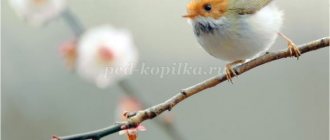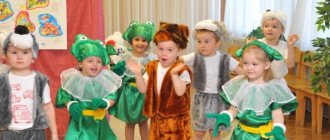Ftskm what is this in kindergarten?
Svetlana Solovyova
Planning for FCCM in the middle group Cognitive development
(FCCM) middle group 2018-2019 . Topic Program content Literature used September 1 – 2 week Knowledge Day. Boys and girls are friends. Pedagogical monitoring Show children the social significance of the holiday - Knowledge Day, cultivate friendliness and responsiveness. Forming ideas about gender differences, developing in children a sense of male and female dignity and the need for self-affirmation as a representative of a certain gender among their peers . Assimilation of norms and rules through play activities accepted in society, education of the moral and ethical qualities of the child (attentiveness, goodwill towards peers of the same and opposite sex) M. A. Kalina, M. V. Karpeeva My city, my region, my country Name your hometown. Give basic ideas about your hometown, region, country. Bring children to understand that there are many streets, multi-storey buildings, and different cars in the city. Cultivate love for your hometown, region, country. M. V. Karpeeva p. 60 Kindergarten. Professions To develop children's interest in kindergarten. Introduce children to the main premises of the kindergarten and the staff of the institution. Cultivate respect for kindergarten workers. M. V. Karpeeva page 5 October Autumn. Trees in autumn. Summarize primary ideas about autumn based on the essential features of the season; to form ideas about the diversity of natural phenomena in autumn, seasonal changes in nature; teach children to recognize trees by their leaves, fruits, and characteristic features of the trunks. Research activity: examining and comparing tree leaves (by shape, size, color)
;
properties of wet sand. M. V. Karpeeva p. 10, p. 25 M. P. Kostyuchenko p. 109 Vegetables. Garden. Strengthen the skills of using the general concept “vegetables”
.
Introduce the names of the main vegetables, their color, shape and taste; a place where vegetables grow. Research activity: Examining vegetables through a magnifying glass. M. V. Karpeeva p. 14 Garden. Fruits. Continue to form ideas about garden plants. Introduce children to the general concept of “fruit”
, the names of the main fruits, their color, shape, taste;
the place where they grow. Experimentation – experience comparing dried and fresh fruits. M. V. Karpeeva page 18 Traffic rules Introduce children to basic traffic rules; with the name and meaning of a traffic light on the road. To form children's ideas about the need to comply with traffic rules. Research activity: “The ABCs of road safety”
by M. V. Karpeev p. 114 November National Unity Day.
To introduce children to the holiday - “National Unity Day”
, to expand children’s understanding of their native land, the country in which we live.
Develop curiosity and listening skills. To instill love for the Motherland, cultivate patriotic feelings, a friendly attitude towards each other, and a desire to come to the rescue. abstract Forest. Berries. Mushrooms Clarify and expand children's vocabulary on the topic. Introduce children to the appearance and basic names of mushrooms, forest and garden berries. Tell us about the places where they grow. Give the concept of edible and poisonous mushrooms and berries. Tell us what can be prepared from berries and mushrooms; form a generalizing concept of mushrooms and berries. Search and research activity: “How not to get lost in the forest?”
, “How to distinguish a double (mushrooms?” M. V. Karpeeva p. 30 Toys Introduce children to the general concept of toys; their name, the purpose of toys; the materials from which they are made; tell how to handle them. Enrich the content of children’s games , develop independence in choosing games, activate the vocabulary based on in-depth knowledge about toys. Research activity:
“What are toys made of?”
M. V. Karpeeva page 5 Clothes. Shoes. Hats. Clarify and activate children’s vocabulary on the topic. Form their ideas about the general concepts of
“clothing”
,
“shoes”
,
“headdress"
. Introduce children to the main types of clothing and shoes, their parts. Experimentation - experience with fabric. M. V. Karpeeva page 20 December Winter. Wintering birds. To acquaint children with the main signs of winter, with changes in living and inanimate nature; with the general concept of seasons. To acquaint children with wintering birds, their distinctive features; with the structure of their bodies; with the general concept of wintering birds.
Experimentation - experiments with water “What are the properties?”
M. V. Karpeeva p. 48, p. 50 M. P. Kostyuchenko p. 111 Domestic and wild animals.
Introduce children to the names of domestic and wild animals. Explain what parts the body of animals consists of; what they eat, what benefits they bring, their living conditions. To form ideas about the wild animals of Russian forests, about how animals in the forest prepare for winter. Research activities: “Everyone needs water”
,
“In the animal world”
.
M. V. Karpeeva p. 41, p. 45 New Year Expand children's ideas about the New Year holiday, its features (it happens in winter, Father Frost comes with the Snow Maiden; New Year trees are decorated in houses and on the streets) M. V. Karpeeva p. 56 January Folk holidays in Russia to form children's understanding of holidays in Russia (Christmas, Yuletide fortune-telling, Kolyada, Magpies, Larks, about the customs and traditions of our people, introduce Russian holiday traditions, the history of their appearance. develop children's cognitive interest in the history and traditions of their people , develop children's speech, improve the skills of coherent statements. summary Winter fun Introduce children to winter fun; expand ideas about winter; Introduce winter sports; form ideas about safe behavior in winter, research and cognitive interest during an experiment with water and ice. Experimentation - experiment with snow (melts, turns into water)
M. V. Karpeeva Transport Clarify and consolidate children’s ideas about transport.
To introduce some types of transport, to give an idea of the basic parts of a car. Research activity: comparison of different types of transport (find similarities and differences)
.
M. V. Karpeeva p. 63 February Professions Expand and enrich children's knowledge about the variety of professions of adults, using different forms of work. Exercise children in naming and distinguishing professions; improve children’s ability to understand and answer the teacher’s questions in individual words and simple sentences. M. V. Karpeeva p. 79, p. 91, p. 104 Furniture Expand children's vocabulary on the topic. Introduce children to the basic names of furniture; some parts of furniture, with the general concept of furniture. Give an idea of the functional purpose of furniture. Develop memory, thinking, attention. Experimenting with objects and materials. M. V. Karpeeva p. 70 M. P. Kostyuchenko p. 133 Defender of the Fatherland Day Introduce children to the general concept of army; its functions; give an idea of military professions. Systematize knowledge about the Russian Armed Forces. M. V. Karpeeva p. 76 Maslenitsa Give children an initial understanding of the traditions of the holiday. Cultivate interest and love for the history and culture of the native people. Celebrating Maslenitsa through learning folk games. Develop cognitive interest, attention, memory, thinking notes March Mother's Day Give children an idea about the holiday of March 8th. Strengthen their knowledge about mom's name. Develop a desire to help mom. Expand your vocabulary with verbs. Develop attention, memory, thinking. To generalize the child’s social experience through his creative and speech activity, to cultivate a positive attitude towards his mother. synopsis Theater week. Folk culture and traditions. Familiarizing children with household items, their names, and purposes. Expand the idea of folk toys (Dymkovo toy, matryoshka, etc.)
.
Introduce children to folk crafts. Continue to introduce oral folk art. Continue to use folklore in organizing all types of activities. summary Spring in nature Introduce children to the main signs of spring; with spring fun. Explain why people and animals rejoice in spring. Reinforce the general concept of seasons. Games - experimentation: with water “Testing ships”
;
with light “Sunny bunnies”
;
with paper "Pinwheels"
.
Experimenting “When does it pour, when does it drip?”
M. V. Karpeeva p. 82 M. P. Kostyuchenko p. 74 April Our health.
Human. Body parts. Introduce children to the general concept of family; with family relationships. To form in children a basic understanding of the structure of the human body. To form in children ideas about a healthy lifestyle, to achieve conscious implementation of health rules and a responsible attitude towards both their own health and the health of others. Experimenting with air. M. V. Karpeeva p. 85 M. P. Kostyuchenko p. 114 Space to give an idea of the planet Earth , the Moon and the Sun. develop thinking, memory, imagination, fantasy. Give an idea of the profession of astronaut. expand your vocabulary with new words space, astronaut, Earth, rocket, spaceship, star, spacesuit abstract Our health. Human. Body parts. Give children an idea of the parts of the face and their purpose. Learn to form diminutive forms of nouns. Develop basic types of motor skills, learn to coordinate speech with movement. Develop visual and auditory attention, memory, thinking. M. V. Karpeeva p. 85 Fauna of the seas and oceans Introduce children to the underwater world and its inhabitants. Introduce children to different types of fish. Give an initial idea of the structure of fish. Cultivate a friendly attitude towards all living things. Solving a problem situation: “A tanker spilled oil”
Experimenting with water.
M. V. Karpeeva p. 94 M. P. Kostyuchenko p. 112 May Victory Day To form children’s knowledge about the holiday “Victory Day”
. develop in children patriotic feelings for their Motherland. to cultivate respect and a sense of gratitude in children for everyone who defended our Motherland. cultivate a sense of pride and respect for warriors - defenders. abstract Insects. Introduce children to the general concept of insects; names and body parts of insects, their habitats. Develop speech, attention, memory. Research activity "Miracle - the Achatina snail" M. V. Karpeeva p. 111 M. P. Kostyuchenko 58 3-4 week Summer. Wildflowers. Pedagogical monitoring Introduce children to the concept of summer, to summer phenomena in nature. Reinforce the generalizing concept of seasons. Introduce children to the general concept of flowers; names of some flowers, their structure. M. V. Karpeeva p. 108, p. 118
Summary of GCD on FCCM in the middle group on the topic “Furniture”
Directly – educational activities on FCCM (Familiarization with the subject environment) for children of the middle group on the topic “Furniture” with a presentation
Author: Vitskova Marina Viktorovna, teacher of the MBDOU “Kindergarten “Golden Fish” of the Astrakhan region, Chernoyarsk district. This material will be useful for educators when conducting conversations and educational activities on the topic: “Furniture” with children in the middle group. Purpose: To summarize and systematize children’s knowledge on the topic of furniture. To form an understanding that pieces of furniture are necessary for the convenience of people's lives. To consolidate children's knowledge about parts of furniture Objectives: Educational.
Give children an idea of different pieces of furniture and their purposes.
Developmental.
Develop coherent speech.
Expand your vocabulary, develop imagination, thinking, and curiosity. Educational.
To cultivate a caring attitude towards furniture
Preliminary work: Conversation on the topic, looking at illustrations on the topic: “furniture”, reading poems and fairy tales about furniture, guessing riddles, looking at furniture in a group.
GCD
Educator. Let's enjoy the sun and the birds, (children raise their hands up)
And also enjoy the smiling faces
(Smile at each other)
And everyone who lives on this planet,
(raise their hands)
“Good morning!”
We will say together (hold hands)
“Good morning!”
- Mom and Dad “Good morning!” - will stay with us. Educator. Good morning children. I am very glad to welcome you. Today, the children, our favorite doll Nastya came to visit us. And she brought you a box with a riddle, because she knows that you really like to solve riddles. Really, guys? Children. Yes! Educator. Then let's solve the riddle. Mystery. Artemka said to Zina: Our house has become magnificent, Because in the store, We bought a new one... Children. Furniture Educator. Guys, what is furniture? Children. These are items that are needed for sitting, sleeping, relaxing, etc. Educator. Tell me what kind of furniture you know? Children. Table, chair, bed, wardrobe, sofa, coffee table. Educator. Do you think people need furniture? Children. Yes. Educator. That’s right, all furniture is important and necessary for people to have convenience and comfort in their everyday lives. Educator. Well done! Guys, name the parts of the furniture? Children. Seats, handles, legs, backs, drawers, doors, shelves. Educator. Guys, listen to what furniture I will talk about. It has a soft seat, comfortable back and armrests. What is this? Children. This is a sofa. Educator. That's right, well done. Physical school is being held Here is Kiryushka's crib, (spread his arms to the sides)
So that Kiryushka sleeps sweetly,
(squat down, put folded palms under his left cheek)
So that in his sleep he grows up,
(slowly rise)
So that he becomes big quickly
(stands on his tiptoes, stretches his arms up) Educator. Children, the doll wants to tell you something. Doll Nastya. Guys, help me buy furniture for my new home. Otherwise I don’t know where or what furniture to put. Will you help me? Educator. Of course, the children will help you, they know everything with us. Really, kids? Children. Yes. A didactic game is being held: “Where should we put the furniture?” The teacher names pieces of furniture. And the children distribute them into rooms (according to their intended purpose): Teacher. Children. Where will we put the sofa, armchair, coffee table Children. In the living room there is a teacher. We will put the dining table and chairs in Children. In the dining room. Educator. Kitchen units and wall cabinets are needed, where? Children. They are needed in the kitchen. Educator. Guys, where will we put the bed and wardrobe? Children. In the bedroom. Educator. Guys, do you think it is necessary to take care of furniture? How to care? Children. Wash it, wipe the dust, etc. Educator. You see Nastya, our children know everything. Doll. Well done. You have smart children. Now I understand where I will place my new furniture. Thank you guys. And for the fact that you helped me. I give you doll furniture as a souvenir. Play. It's time for me to go to the furniture store. Goodbye (Leaves) Teacher. Well done, children! We worked very well together. What did we talk about today? What do you remember, children? What is furniture for? Does it need to be protected? (Children's answers) Educator. Furniture in the house is taken care of, It creates comfort, A house without furniture is empty, And as if not inhabited.
Presentation on the topic: Furniture
We recommend watching:
Summary of educational activities for children with parents in the middle group. Do-it-yourself doll Summary of a lesson on speech development on the topic “Toys” in the middle group Methodological development of GCD for the development of communicative activities in children of the middle group Synopsis of a game lesson in mathematics in the middle group of a preschool educational institution
Similar articles:
Lesson in the middle group “Winter clothes”
Math lesson notes “Number 1”. Middle group



